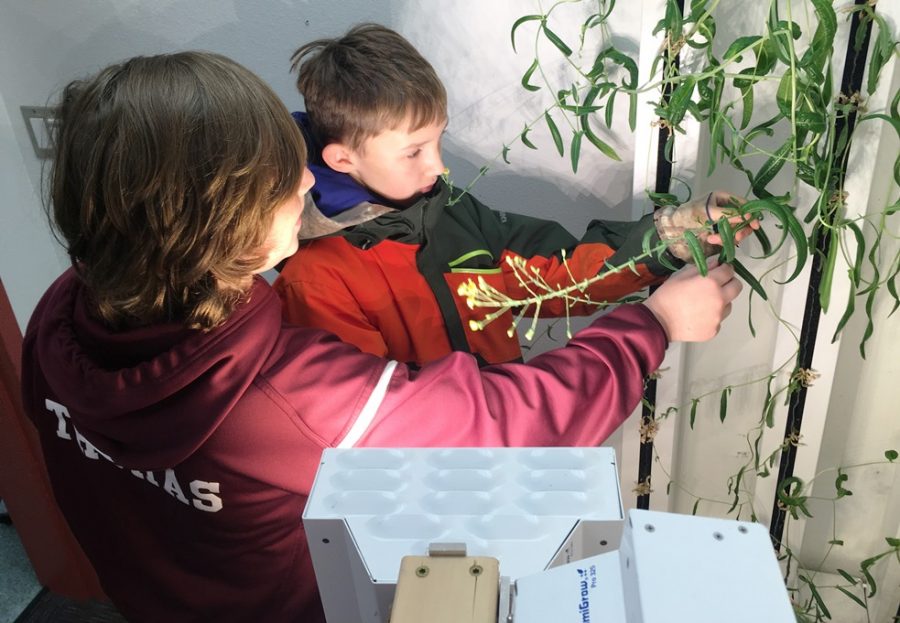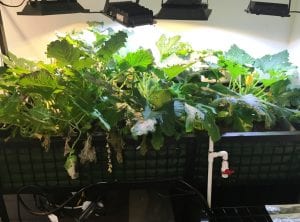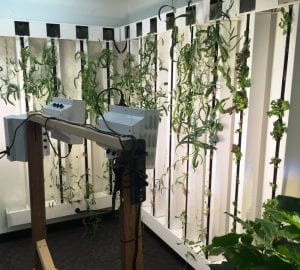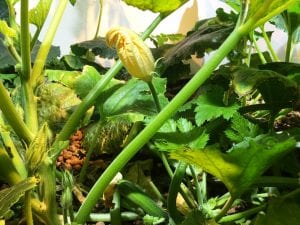
Fawn Mountain Elementary School students Cyress Tibbitts and Declan Thomas check some of the lettuce plants growing in the school’s aquaponics room. (KRBD photo by Leila Kheiry)
Inside a small room at Ketchikan’s Fawn Mountain Elementary School is a lush garden. It’s tended by students, who are growing lettuce, zucchini and … knowledge.
“There’s another broccoli plant here. There’s zucchini, there’s basil growing here… tomatoes,” says Fawn Mountain Elementary School principal Alonso Escalante, pointing to some plants as he gives a little background on the school’s aquaponics room.
Inside the windowless room, there’s a bank of grow lights providing substitute sunshine, and lots of pipes to circulate water throughout the system.
The kids are mostly growing lettuce now, but there are a few other plants in the mix.
“It’s a work in progress and once we get it dialed in, it’ll be really interesting to see how much food we can actually grow,” Escalante said. “The ultimate goal is to see if we can actually produce food for our own cafeteria. See if we can get some lettuce into our salad bar, those sorts of things.
Escalante didn’t get into too much detail. Because he wants the school’s young gardeners to show off how the system works.

Plants grow in the Fawn Mountain Elementary School aquaponics room. On the table are zucchini, tomatoes, basil and lettuce. (KRBD photo by Leila Kheiry)
Soon, two sixth-graders arrive: Bree Johnson and Everr Kistler.
Everr points to a tank of water next to a large table covered with plants. Swimming inside the tank are fish.
“The fish poop in the water and it does this thing to the water and it makes the plants grow,” he said.
That thing the fish poop does is fertilize the water. The fertilized water then circulates among all the plants through the pipe system, feeding them the nutrients they need.
Bree said they don’t have to add more water too often. She points out some of the plants on the table, growing in porous rocks – broccoli and cabbage, she thinks; then Everr describes the plants growing in vertical planters attached to the wall – different kinds of lettuce.
They each pinched off a lettuce leaf to eat. I ask Everr how he likes it.
“Tastes better with ranch,” he said.

Vertical planters are attached to the wall in Fawn Mountain Elementary School’s aquaponics room. The vertical planters are growing mostly lettuce. (KRBD photo by Leila Kheiry)
Cyress Tibbitts and Declan Thomas are my next two tour guides. Cyress tells me a little more about the vertical planters.
“This is the vertical growing station. It’s where you put the plants to grow vertically, up and down,” he said. “And there’s water dripping down to water the plants. It never stops.”
Declan added that the water, fertilized with fish poop, filters through the plants before heading back to the fish tank.
There are some tiny bugs flying around room. Declan said that wasn’t planned – the insects just showed up. But it’s a good thing, he said, “because we wouldn’t get fruit if they didn’t spread the stuff around. We’d have to get cotton swabs and get pollen and move it from other plants. But the flies do the work for us.”
Declan said that all the plants are grown without pesticides.

Plants grow in porous rocks in the tabletop planter at Fawn Mountain Elementary School’s aquaponics room. (KRBD photo by Leila Kheiry)
Escalante said Fawn Mountain’s aquaponics project started after the school won a grant from the local U.S. Coast Guard’s Chief Petty Officers Association. That group funds different projects each year through its annual Halloween Haunted House event.
“That was kind of the seed, so to speak — no pun intended – that got this whole thing going,” he said.
The original plan called for a separate greenhouse on school grounds, but building and heating that structure proved too costly. The aquaponics room is more budget-friendly, and with it students are learning valuable lessons, among them how to grow their own food.





